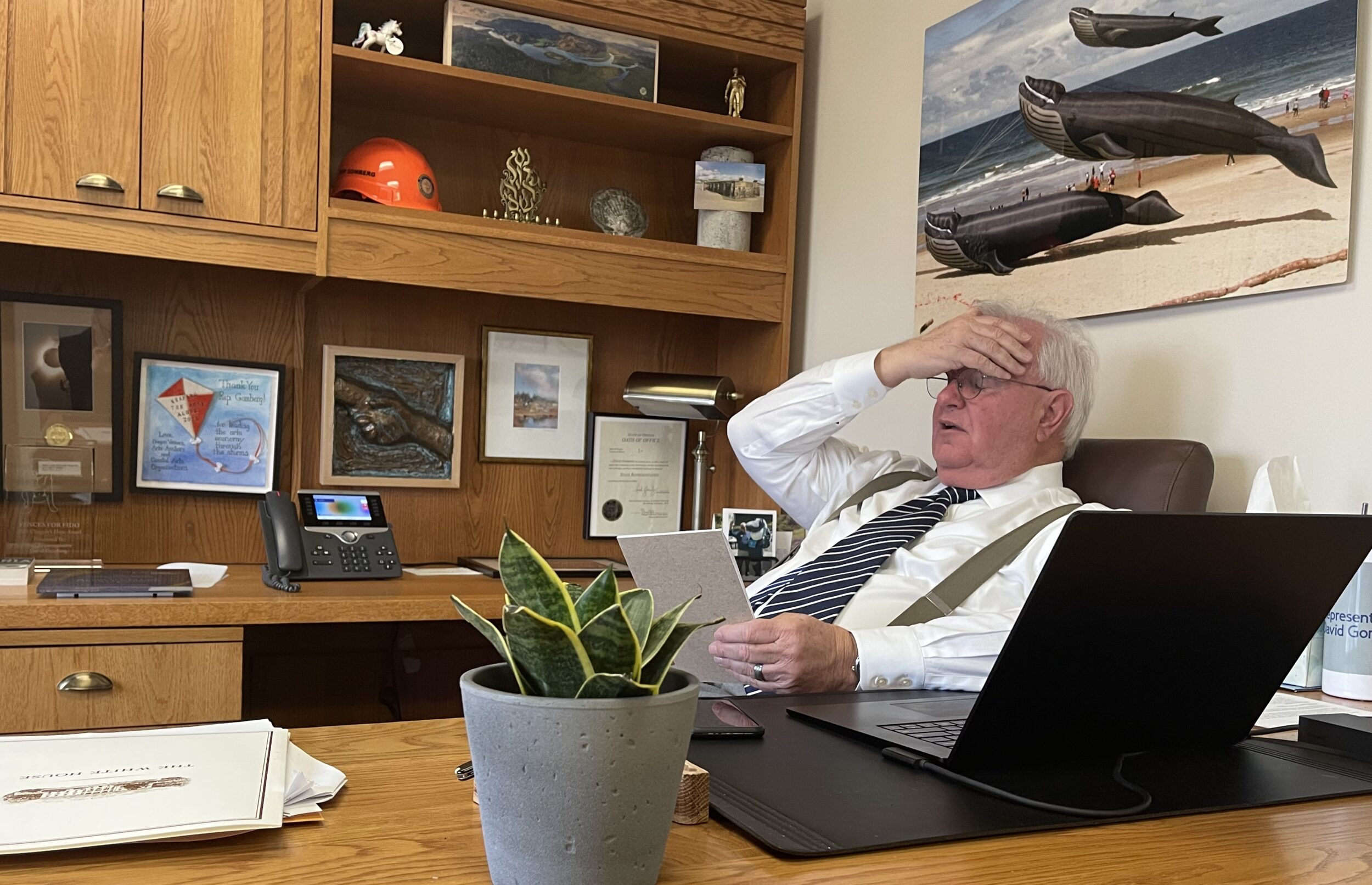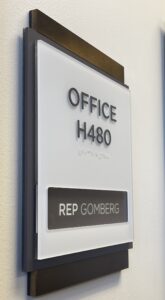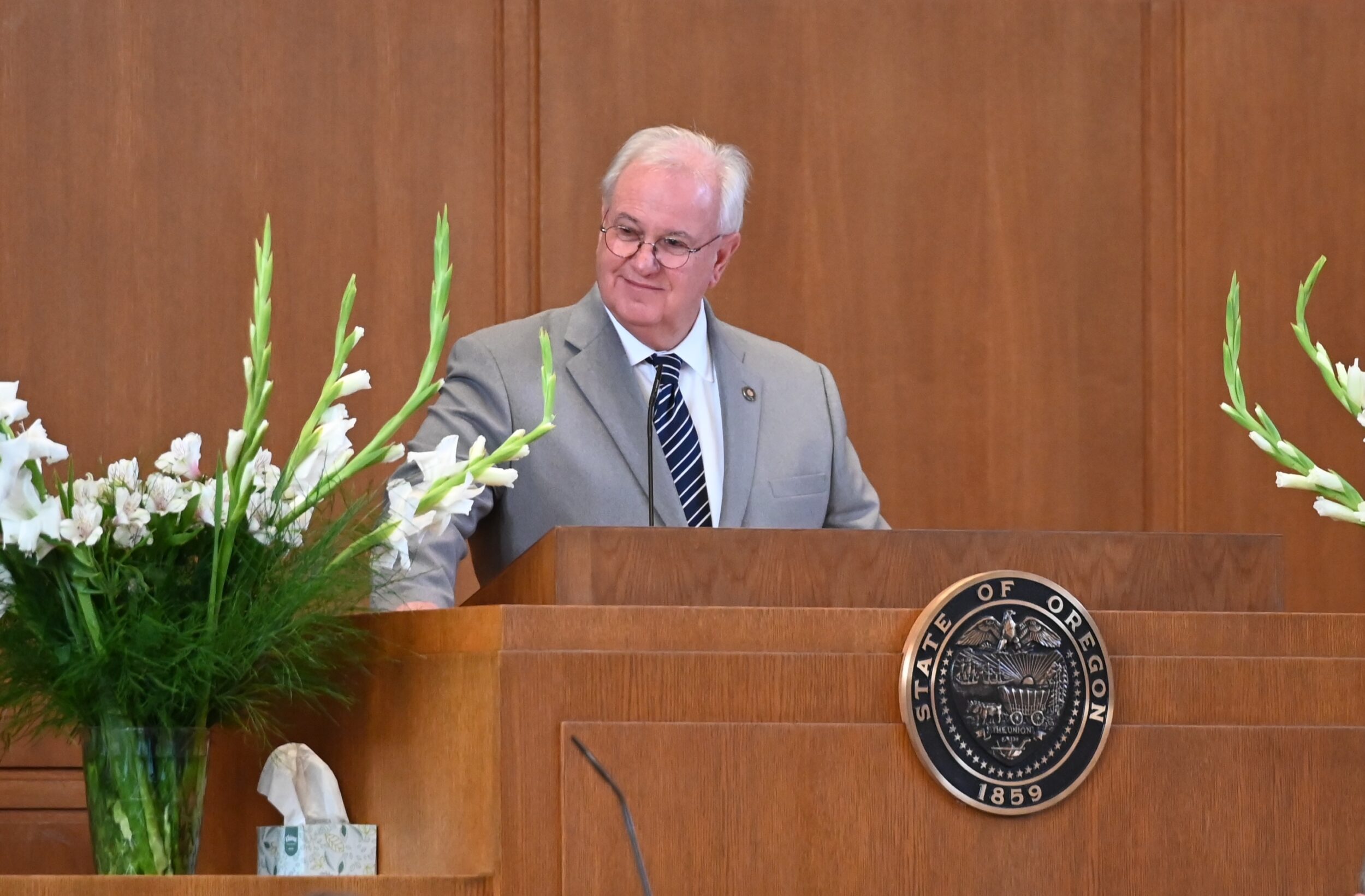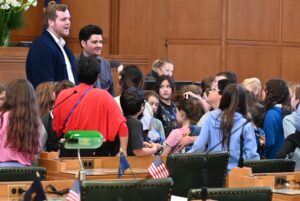
- Quinton Smith/YachatsNews
By BRAD FUQUA/Philomath News
SALEM — It’s Day 18 of the Oregon State Legislature’s short session — just past the halfway point.
Walking along State Street toward the back entrance to the State Capitol on Thursday, Feb. 22, a group of sharply-dressed individuals with briefcases and backpacks pass by on the sidewalk. I’m suddenly concerned that I should’ve opted for a more professional look, at least maybe the wingtips I bought for my son’s wedding instead of black-and-white Adidas running shoes.
Still, I am who I am and pushed those thoughts out of my mind while walking up steep steps toward the entrance. My camera bag rolled through a security screening machine and I collected the belongings out of my pockets from a plastic bowl. Then it was down a hallway toward the House of Representatives wing and up an elevator to the fourth floor.
At the end of the hallway, I arrived at the office of David Gomberg, D-Otis, who serves as the House District 10 representative in the Oregon Legislature. It’s a district that covers all of Lincoln County and for the past year part of west Benton and small slice of Lane counties.
Several months ago Gomberg was in Philomath he suggested that I visit the State Capitol during the upcoming regular session. “I’m going to pull the curtain back and let you see some of the stuff going on behind the scenes,” Gomberg told me.

I went into this without really knowing the angle on the story — basically, that it would be some sort of feature about a “Day at the Capitol.” As we talked, the question that popped into my head was simple: “Why do you do this?”
It’s a question that I’ve pondered with others who serve in public office from city committees and the Philomath School Board on up to state and federal positions. I’ve covered meetings, I’ve seen these folks in action, I see the comments on social media and I know former holders of public office who say “enough” after one term. Why would you want the job?
“I ask myself that question all the time,” Gomberg said, half kidding. “There are good days in the Capitol and there are other days in the Capitol.”
A good day, he said, is when he’s able to make something happen for people.
“Sometimes that’s getting $2 million for a water system or for rodeo stands or for paving a highway,” Gomberg said. “There are also good days when somebody calls up and says ‘I couldn’t get my unemployment check’ and that they’ve been on hold for three hours with the Employment Division … they call us and we’re able to make some phone calls.”
He provided a few more examples.
“So you can make a difference in a community and you can make a difference in a family,” he said. “Those are the things that keep me going. And I’ve been here 12 years now. There are plenty of good days and plenty of other days.”
Perhaps that’s “politician-speak” but I felt like the man was being genuine with his answer. We didn’t get into the “other days” but you can imagine the frustrations and roadblocks that a state lawmaker encounters while trying to accomplish business.

12th year in District 10
Gomberg was first elected to his seat in 2012 and is now in his 12th year serving the district, moving up to fourth in seniority in the House. He’s already filed for re-election in the May primary. Redistricting put Philomath in Gomberg’s district a year ago.
Along the same lines of what motivates him to work as a state lawmaker, I wondered if the man has any intentions of slowing down. I mean, he’s 70 years old, he’ll be 71 in June. I’m not sure if I really want to be working when I’m in my 70s.
“Susan and I have been married 38 years and we built a business together and the nature of our business meant that we were sitting across the desk from each other most days or we were traveling together and doing events together,” Gomberg said. “We had the benefit of spending more time together than most married couples do. And when I came to the Legislature, that changed. Now suddenly I was in this different model where I come home at the end of the day … that was a big change for us. And I suspect there are days when she appreciates me being away instead of across the desk from her every single day.”
The Gombergs owned a successful kite business in Lincoln City for years. Over the years, he became an authority on kite flying and held various positions in organizations and won awards. They shut down the company six or seven years into his life in the Legislature.
When not in Salem or at home, he’s traveling around the district.
“I love the engagement and I think it’s really important that people see you and get to know you and feel like they can call you up if they’ve got a concern or an idea or a problem,” Gomberg said. “And if they know you, I think that’s easier for them. That’s one of the reasons and I also do it because it helps me understand what’s going on in our communities.”
A freight train
The short session started Feb. 5 and lasts 35 days in all until March 10. Gomberg describes it as a freight train — in other words, making sure that everything he wants to deliver is moving and not getting lost.
“You know, the short session is like a long session in fewer days,” he laughed. “Because in a long session, we have 3,000 bills and in a short session, we have 300 bills. But in a long session, we’ve got six months to work and in a short session, we’ve got six weeks to work them. So it’s a scramble.”
Luke Harkins, Gomberg’s chief of staff, said the short session is a sprint, not a marathon like the regular session.
“In a short session, there’s a two-bill limitation on the legislators so the volume is definitely more manageable,” Harkins said. “But the key to a successful short session, I believe, is the work that goes on preceding the session. I like to think that everything we do leading up to a session, if halfway through, we’re in ‘hurry-up-and-wait mode,’ we did it right.”
As luck would have it, there was a Philomath flavor to the day at the Capitol. Among the conversations would be meetings with those from the timber industry about mill closures and the Oregon Department of Transportation about the status of the downtown streetscapes project. Plus, a group of fourth graders from Philomath Elementary School were scheduled to visit in the afternoon.

In addition, Gomberg found himself in the lead role for Thursday’s floor session, taking the dais to move along the business of the day.
“There are three people who normally manage the floor sessions — the speaker, the president pro tempore and I’ve become the No. 3 go to,” Gomberg explained. “Last session, I did it a lot, particularly toward the end of session when the speaker and the president were engaged in negotiations.”
During this session, Gomberg hasn’t led from the front of the chamber quite as much. But on Thursday, House Speaker Dan Rayfield, was off the floor and the president pro tempore, Rep. Paul Holvey, D-Eugene, was coming and going.
Said Gomberg about the session, “When we had close votes, I had to hold the gavel or hold the vote until everybody could come back in.”
The eight-hour visit to the Capitol was interesting and I learned a few things along the way (for example, a lot of what happens is all about an “ask” — you’re either making an ask or listening to an ask). Gomberg and his staff went out of their way to make me feel welcome and didn’t seem to hold back just because I was hanging out and listening and watching everything they were doing.
To bring this all together, I kept an hour-by-hour account of the day’s events. I will say this about sitting in on meetings. Gomberg and I agreed that I was there “on background” — a common term in journalism. What that means is that I’m free to report on general topics of the meeting but will not attribute information to a specific source. The representative wants to hear unfiltered perspectives and factual reports from these folks with no holding back because there was a reporter in the room.

What the day looked like
• 8 a.m. — Gomberg invited me into his office and we had a casual conversation before he went through his schedule. A couple of issues directly related to Philomath were to be covered in the meetings that followed, including a recent timber mill closure and the Philomath streetscapes project.
• 8:15 a.m. — The representative and his staff discussed what was on their plate for the day along with various other matters. Mentioned were 422 emails in Gomberg’s in-box — nearly 200 of them being “form letters” related to a house bill on water infrastructure that were apparently asking for his support. Gomberg is one of the bill’s sponsors. They also talked about a press release on renewable energy and an interview with an Oregonian reporter about the water infrastructure package scheduled for later in the day.
• 8:35 a.m. — Gomberg met with forest industry representatives on recent timber mill closures, including the Interfor sawmill in Philomath. Christopher McMorran, a Philomath city councilor who is the chief of staff for Rep. Lisa Reynolds, D-Beaverton, sat in on the meetings. In basic terms, all involved seemed to believe that Oregon needs to get going on building more houses to stimulate the need for lumber. Dramatic fluctuations in the price of lumber factor into all of this.
• 9 a.m. — A representative of the Oregon Governor’s Office of Film and Television followed with a rundown of current and future projects, including the recent wrap of the film, “Alma and the Wolf,” in the Tillamook and surrounding area. Gomberg promoted his district as great places to shoot movies and TV series and there was mention of a film looking to spend a couple of days at Lincoln City in the near future.
• 9:20 a.m. — The next meeting was with an Oregon Department of Transportation representative who provided an update on the Philomath streetscapes project. The project remains on schedule and there was some talk with ODOT about how to maneuver around the Sip and Stroll downtown event that occurs in July. A few other topics came up as well, including trying to combat graffiti on signs, which can actually create a dangerous traffic situation, something Gomberg had experienced himself.
• 9:30 a.m. — Gomberg then met with two labor organization representatives on House Bill 4045, which relates to adjustments in classifications under the Public Employees Retirement System. A conversation on Oregon worker relief followed.
• 9:50 a.m. — With scheduled meetings now wrapped up, Gomberg had to head to an hour-long caucus meeting. This was the only stretch when I could not accompany him — those discussions are off limits, even to his own staff.
• 10:50 a.m. — Harkins took me down to the House chamber in anticipation of the upcoming floor session. The sergeant-at-arms went over the rules for media access and I was pleased to hear that there was a desk where I could sit with my laptop. Photos from that spot, however, are not allowed so in order to shoot images, I needed to walk off the floor and into the gallery. I also completed a quick interview with Harkins.
• 11:08 a.m. — Gomberg, who is the No. 3 legislator in line to lead a House session, got the call to take the dais and he called the meeting to order. I’ll admit as I was sitting there, the floor struck me as having a majestic feel to it. A huge mural watches over the proceedings — it illustrates the historic meeting of Oregon pioneers at Champoeg in 1843 when the provisional government was established. In addition, the carpeting features the Douglas fir (the state tree, in case you didn’t know) and the chamber is constructed of golden oak.
• 11:10 a.m. — Following the pledge of allegiance, the Eagle Point High School brass ensemble played a number to open the session.
• 11:12 a.m. — Time was provided to the representatives for courtesies, which are basically short speeches to introduce visitors, bring attention to issues or events and so on.
• 11:19 a.m. — The verification of a quorum took place with 57 present and three excused.
• 11:21 a.m. — The business of the session then began with readings, comments and consideration on various bills. The majority of this part of the proceedings was spent on House Bill 4059, which relates to canola regulation. In the end, the House voted to keep a cap on canola farming in place into 2028. At one point, I noticed the sergeant-at-arms passing out something to students in the gallery — it might’ve been pins. There were stretches when it was difficult to hear what was going on with construction noise ongoing in the background.
• 1:29 p.m. — Gomberg adjourned the session until 11 a.m. Monday. The proceedings went on much longer than anticipated which forced the rescheduling of some meetings and appointments. The interview with the Oregonian reporter, for example, was delayed until the next day.
• 1:33 p.m. — Through a request to the sergeant of arms and with Gomberg coming over to the media desk where I was seated, I went out onto the floor to shoot a few photos, including one of the representative standing near his desk. Gomberg took me up to the dais and illustrated the system in place to run the session.
• 1:40 p.m. — Gomberg grabbed some food and ate at his desk while chatting with staff on a few topics.
• 1:44 p.m. — Gomberg became concerned over his schedule after he was told that Philomath Elementary students set to arrive at 2:45 were running late after a visit to Fort Vancouver, Wash. The representative was scheduled for a 5 p.m. appearance at the Newport Seafood and Wine Festival and had to be on the road in time to make it.

• 2:04 p.m. — I conducted a follow-up interview with Gomberg, which transitioned into a conversation about the price of used cars.
• 2:11 p.m. — Gomberg met with a few more people on topics such as a beer and wine tax study that was in the news and an update on water infrastructure. Twice during the day, I heard Gomberg reference a $12 million sewer problem in Siletz, a town with 1,100 people that serves as an example of small towns not able to afford big projects. Money out of an infrastructure package that contributes a good amount toward the cost would be significant for the tribe and those residents.
• 3 p.m. — Gomberg leaves to make the drive to Newport. He expressed disappointment that he was not able to meet with the Philomath kids.
• 3:05 p.m. — A constituent dropped by with information for Gomberg on a project in Newport. A few minutes later, another individual stopped with points to make related to a specific bill. The number of people making the rounds in person (“Is Luke around … Have you seen Luke?) and on the phone seems to occur at a brisk pace. Luke — as in Harkins, his chief of staff — had a large number of yellow sticky notes to go through after he had been away from his desk for a little over a half hour.
• 3:35 p.m. — Gomberg phoned in from his car — also known as his “remote office” as he calls it — to discuss an issue with staff.
• 4 p.m. — The Philomath fourth graders arrived at the Capitol and were taken onto the floor of the House chamber, which was not in session. Typically, only representatives can lead a group onto the floor but his chief of staff received permission in Gomberg’s absence. Harkins and McMorran seemed to do pretty well with them. I especially liked McMorran’s literal explanation of working “across the aisle.”
• 4:20 p.m. — After watching the presentation with the kids and shooting some photos, I made my way out of the Capitol and toward my car on State Street.
- Brad Fuqua is publisher/editor of the Philomath News. He can be reached at News@PhilomathNews.com


